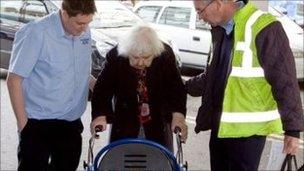Patients' taxis cost NHS millions
- Published

Patient transport services are mainly run by ambulance trusts
More than 拢30m has been spent on taxis for NHS patients since 2008 because of a shortage of official non-emergency transport, the 大象传媒 has learned.
The figures cover the transfer of patients who are too ill to travel by themselves, such as those with broken limbs or receiving chemotherapy.
Ambulance trusts in England, Wales and Northern Ireland responded to a 大象传媒 Freedom of Information request.
Health chiefs insisted the practice was not putting patients at risk.
But they admitted they were aiming to reduce the use of taxis amid concerns that their use was not providing value for money.
The North West Ambulance Service has spent the most on taxis - 拢9.9m since April 2008, on more than 500,000 journeys. However, like many trusts it said it was in the process of reducing its reliance on them.
Some trusts also provided information on the most costly taxi journeys they had paid for.
These included two fares in excess of 拢700. One was for a 184-mile journey from Cambridgeshire to Bristol when a patient was discharged from Papworth Hospital, while the second was for a 151-mile trip from Chase Farm Mental Health Hospital in north London to Shrewsbury, Shropshire.
Regular use
Patient transport services - provided free to those who are too ill or unable to travel to and from hospitals - are mainly run by ambulance trusts, although private firms are used in some places.
The services rely on specially adapted vehicles - normally minibuses equipped with basic medical supplies such as oxygen - staffed by trained crews to ferry patients around.
For those who do not need any medical assistance, official ambulance trust cars can be used to drive them.
But when neither of these options are available, they have to turn to private taxi companies.
Only the South East Coast Ambulance Trust has avoided paying anything out to taxis in the past three years, while London has reduced its reliance on them to under 100 journeys a year.
The figures show that all other ambulance trusts use taxis on a regular basis.
Value for money
Sara Gorton, from Unison, expressed concern about taxi use.
"There may be occasions where it is unavoidable, but while these are not patients who have dialled 999, there will be times when they will need someone with more skills and training than just how to drive.
"But our concerns about [patient transport services] go wider than use of taxis. There are big differences in the way that patient transport is provided and what standards are kept to in different areas.
"Increasingly, services are being outsourced to private firms which means that competition is based on costs, and standards are being driven down. This also means it's harder to find out what is happening."
But Delwyn Wray, the director of patient transport services at North West Ambulance Trust and vice-chairman of the National Patient Transport Service Group, said while there was concern about taxi use, it was on value-for-money grounds rather than safety.
"Anyone needing medical help in any way would not go by taxis."
But he added: "I think there will always be a need for them at times, but each service needs to look at how they are using them and whether there is a more efficient and better way of transporting patients. That is what we are gearing up to in the North West."
The Department of Health said it was up to local NHS chiefs to decide about who transported patients.
Data for how much was spent on taxis in Scotland was not available.